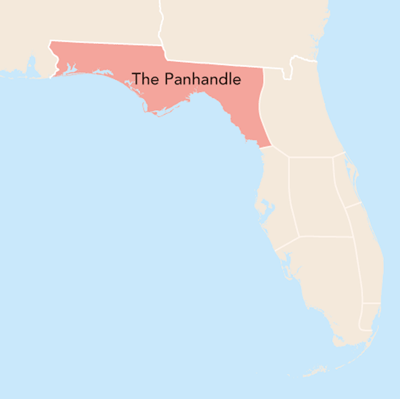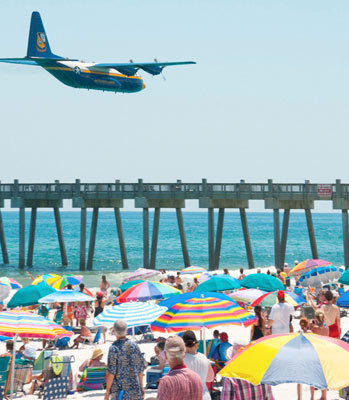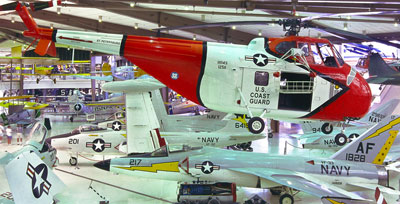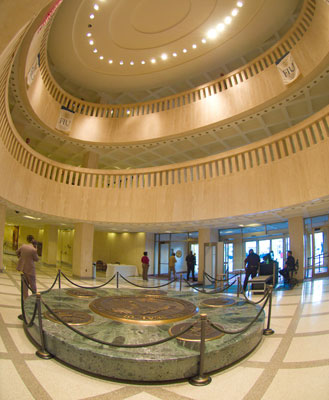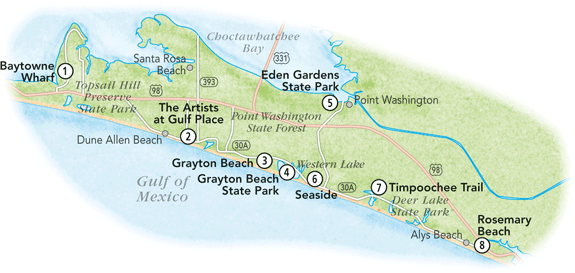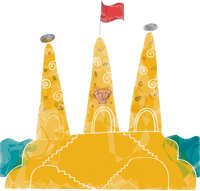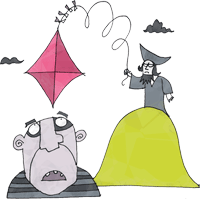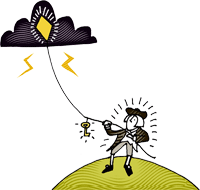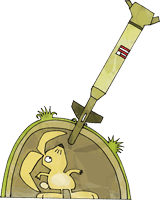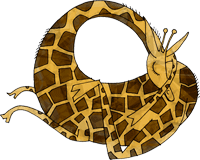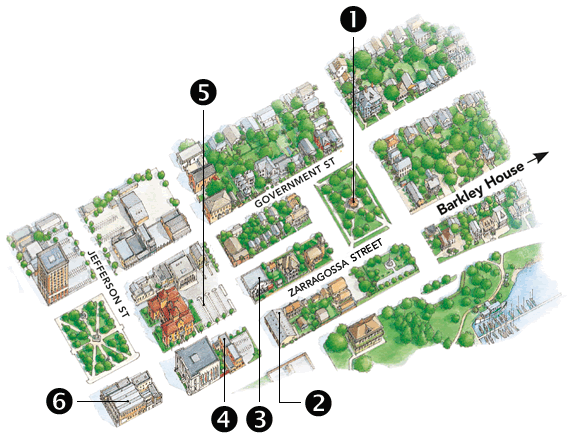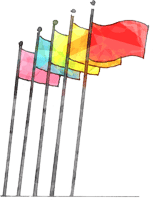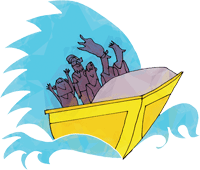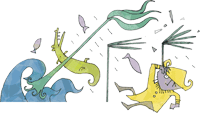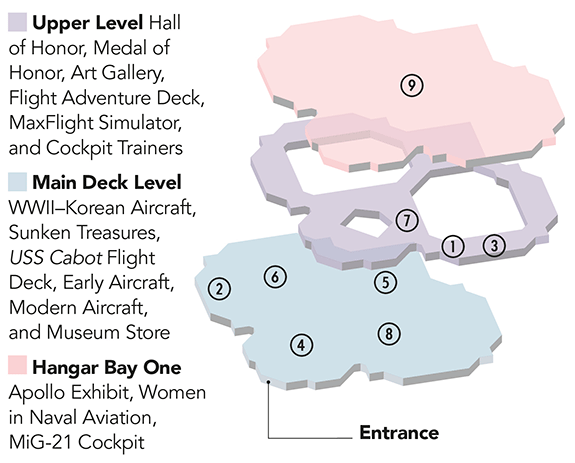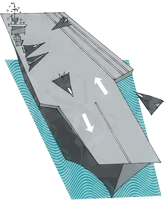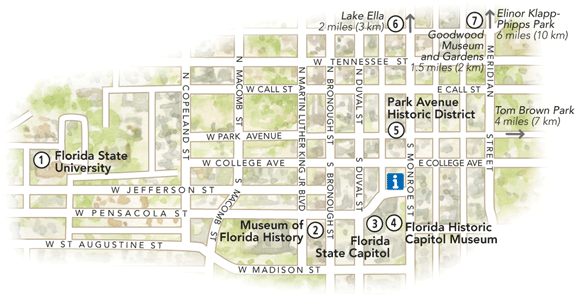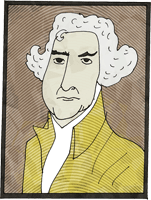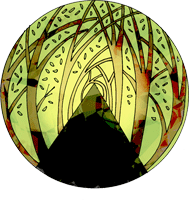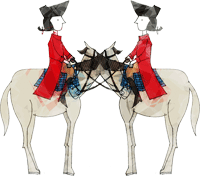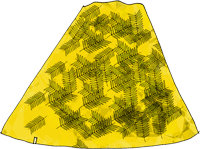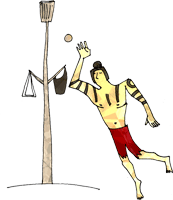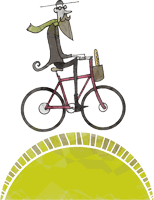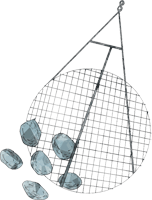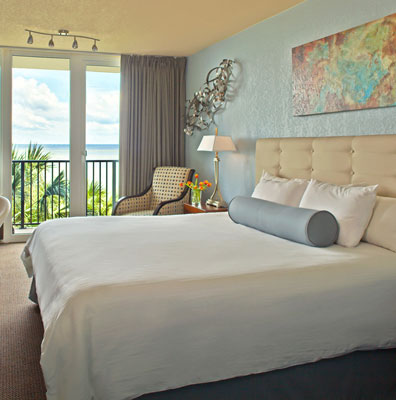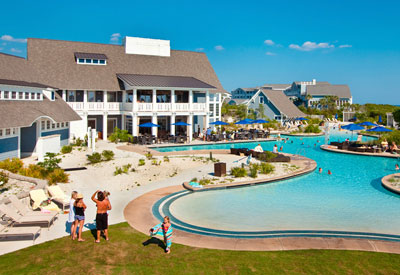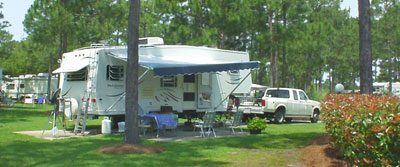< The Panhandle
The Panhandle
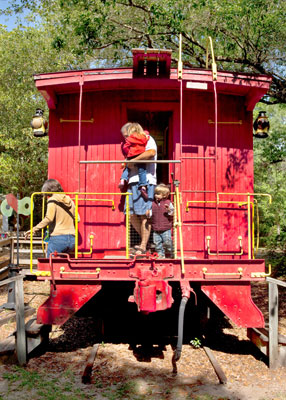
Family exploring the Seaboard Air Line caboose,
Tallahassee Museum
The Panhandle stretches for some 300 miles (483 km)
across the northwest corner of the state, between the Gulf of Mexico and
the southern states of Alabama and Georgia. Most families head straight
for the beach resorts that extend in an arc between Pensacola and Panama
City, but the less-explored interior – a hilly, pine-forested landscape
unusual in Florida – also offers plenty of recreation. Though the region
is large, excellent highways make it easy to navigate by car: I-10 links
Tallahassee and Pensacola, and Highway 98 serves the beach towns.
1. South Walton
2. Air Force
Armament Museum
3. Gulf World Marine
Park
4. ZooWorld
Zoological & Botanical Conservatory
5. Pensacola
6. National Naval
Aviation Museum
7. Tallahassee
8. Mission San Luis
9. Tallahassee
Museum
10. Alfred B. Maclay
Gardens State Park
11. Wakulla
Springs State Park
12. San Marcos de
Apalache Historic State Park
13. Apalachicola
< The
Panhandle
1. South Walton
Sparkling beaches and village charm
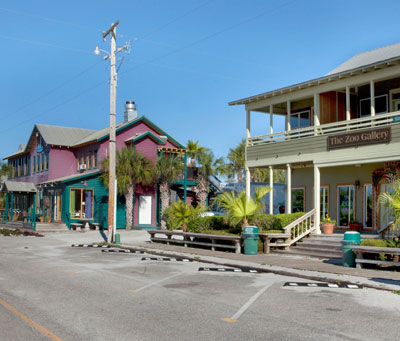
Grayton Beach, a charming beach town
Lying between the high-rise buildings in Fort
Walton and Panama City are 26 miles (42 km) of the finest beaches in
Florida. The South Walton shoreline boasts sand that is almost pure
quartz crystal, dazzling white to the eye, and soft underfoot. Lined
with a string of low-rise, quiet villages, the beaches are great for
families. Just under half of the region is preserved as state parks
and forests, and opportunities for recreation are plentiful.
Key Sights
1. Baytowne Wharf This lively enclave
along the shores of Choctawhatchee Bay has boutiques, eateries,
and the Baytowne Wharf Adventure Zone with a climbing wall and a
zip line for adventure-lovers.
2. The Artists at Gulf Place This
cooperative artists’ colony and open-air market in Santa Rosa
Beach is one of many colorful spots in South Walton where local
art is featured.
3. Grayton Beach A laid-back town with
narrow, oyster-shell-paved lanes, this is the oldest community
on the shore. Here, weathered cottages blend with modern beach
houses, shaded by pine and oaks.
4. Grayton Beach State Park
Award-winning beaches, pine forest, and a nature trail through
the dunes with views of scenic Western Lake make this park a
special retreat.
5. Eden Gardens State Park The
restored, antique-filled Wesley House, a typical Southern
mansion of the 19th century, inspires visions of hoop skirts and
Scarlett O’Hara in Gone With the Wind. Picnic along
Tucker Bayou, and explore a nature trail and lush gardens shaded
by moss-draped live oaks.
6. Seaside Developed in the 1980s,
this planned village has quaint pastel-colored cottages, and
lanes laced with sandy paths that lead to the beach, shops, and
restaurants.
7. Timpoochee Trail Running the full
length of Scenic Highway 30A, this superb 23-mile (37-km) bike
path winds through the beach communities, along coastal dune
lakes, and through picturesque scenery with views of the Gulf of
Mexico.
8. Rosemary Beach Inspired by the
Seaside model of a walkable village, this town has a mix of
architecture, some with a New Orleans influence, and a wide
village green.

Left Seaside village
Middle Sculptures at Eden Gardens State
Park Right Rosemary Beach
Kids’ Corner
Beach fun
Digging in the sand, playing in the waves,
and building sand castles are some of the popular activities
on the Panhandle’s beaches. What else would you add to the
list?
Trial by kite
Around 300 years ago, judges in the US
flew kites above people accused of crimes. They believed
that the kite would dip down over a guilty person.
Taking off
South Walton’s beaches are perfect for
kite-flying. Probably the most famous kite-flyer in history
was American politician Benjamin Franklin, who, in 1752,
flew a kite into a storm cloud to see if electricity would
be conducted down its string. A key was attached near the
bottom. The kite was struck by lightning and, when Franklin
moved his hand toward the key, a spark jumped across and he
felt shock, proving that lightning was electrical. Don’t try
this at home – it could be fatal!
< The
Panhandle
2. Air Force Armament Museum
Take flight
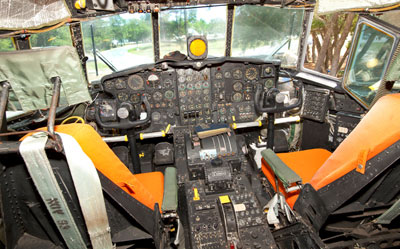
Inside the cockpit of an aircraft at the Air Force
Armament Museum, Fort Walton
This museum is located on the Eglin Air Force Base,
home of the Air Armament Center (AAC), which is responsible for the
development of air-delivered weapons. Start outside the building, where
there is a lineup of over 20 military planes to inspect. These date from
World War I to the present, and include the SR-71 Blackbird, the fastest
plane ever built. It can fly at over 2,200 mph (3,520 km/h)! Inside the
museum are four more vintage aircraft and an amazing collection of
bombs, missiles, and rockets, as well as interactive displays including
one that works the controls of a mock cockpit. Check out other
fascinating exhibits, such as “bunker busters,” bombs that can hit
targets deep underground. There is also a 30-minute film that
illustrates the AAC’s history and accomplishments.
Kids’ Corner
Find out…
How fast is the fastest plane
in the world, the SR-71 Blackbird?
How high can the SR-71
Blackbird fly?
What is the name of the bomb
that can hit targets underground?
What is the name of the
radar-guided missile that can fire at many targets
at once?
< The
Panhandle
3. Gulf World Marine Park
A kiss from a seal
Dolphins show off flips and leaps, seals kiss willing
spectators, and parrots and reptiles perform in the daily live shows
that are the specialty of this aquarium. There is also a delightful
magic show that features spectacular illusions, comedy acts, special
effects, and interactions with the audience. The aquarium’s inhabitants
include sharks, alligators, penguins, iguanas, and sea turtles. Watch
shark and sea turtle feeding sessions, as well as underwater scuba
demonstrations, before heading for the stingrays that await visitors in
their petting pool.
Kids’ Corner
Seashore scavenger hunt
How many of these can you find at the
beach?
A bird on the sand
A bird in the air
A smooth pebble
A crab
A broken shell
A whole shell
Sea grass
A sand dune
A beach umbrella
< The
Panhandle
4. ZooWorld Zoological & Botanical
Conservatory
A small animal kingdom
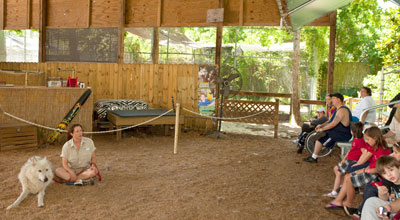
Wolf Show at the ZooWorld Zoological &
Botanical Conservatory, Panama City Beach
This little local zoo offers up-close views of over
250 animals in a tropical garden setting. Children can learn all about
parrots, reptiles, and alligators at the live shows, and even pose for
pictures with them. The petting zoo houses lots of farm animals for
feeding, as well as a camel. A raised walkway allows for a special
treat: feeding Sydney the giraffe. The zoo is especially recommended for
younger children.
Kids’ Corner
Giraffe geography
Giraffes are the tallest animals in the
world. They can grow up to 19 ft (5.7 m) tall, and have very
long necks that help them to reach for tender leaves growing
on trees – their favorite food. They sleep standing up,
which must be a lot easier than trying to get that long body
to lie down.
< The
Panhandle
5. Pensacola
Beaches and the Blue Angels
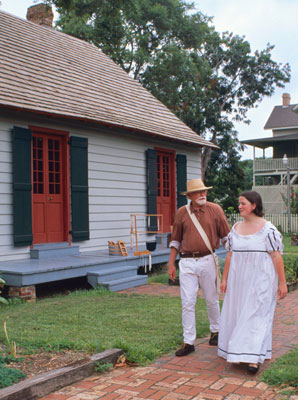
Costumed guides in the Historic Pensacola
Village
A distinct Southern accent borrowed from the
neighboring state of Alabama, and influences from a colorful past,
give Pensacola a unique flavor. The Historic Pensacola Village, its
oldest quarter, comprises 27 buildings and museums reflecting 450
years of history. Two of the city’s best family attractions are the
superb sands of the Gulf Islands National Seashore and tours of the
National Naval Aviation Museum, where the famous Blue
Angels stunt flyers practice.
Key Sights
1. Seville Square The heart of
Pensacola when the area was first settled by the Spanish, this
square served as the parade ground for the Fort of Pensacola
during British rule in the 1770s.
2. Museum of Commerce This
reconstruction of Pensacola’s late 19th- and early 20th-century
streetscape features a print workshop, and leather and harness
shops.
3. Museum of Industry Exhibits
depicting the industries that helped build the city – fishing,
brick-making, lumber, and railroads – include a vintage fishing
boat and a 1905 locomotive.
4. Pensacola Children’s Museum Its
many imaginative exhibits and dress-up period clothing make this
museum a great place to take younger kids.
5. British Officer’s Compound Built
during the early years of the American Revolution, this
compound’s foundations are among the many finds that form
Pensacola’s Colonial Archaeological Trail.
6. Pensacola Museum of Art Once a
jail, this building now houses contemporary art, decorative
glass, and African tribal art.
• Barkley House Built
in 1825, this is the oldest surviving example of a “high-house”
in the city. Tours of the Historic Pensacola Village include a
stop at the house, where visitors can learn about the Barkley
family.

Left Barkley House
Middle Museum of Commerce
Right Seville Square
Kids’ Corner
Test your Pensacola IQ
The flags of five different
countries have flown over Pensacola during its
long history. Which country was the first, and
which was the last?
Pensacola got its name from
the Native American tribe that greeted the first
Spanish explorers in 1559. What were they called?
Which city was the original
capital of Florida?
Miles of bliss
Along Florida’s heavily built-up shoreline
are some magical stretches of unspoiled beach, known as
National Seashores, and preserved by the US government for
public recreation. The Gulf Islands National Seashore (
www.nps.gov/guis) offers superb boat rides,
and campgrounds.
Did you know…
In 1559, Pensacola became the first
European settlement in the US. But it didn’t last. A month
later, a hurricane destroyed supplies, causing the Spanish
to flee.
Living in the past
The homes in the Historic Pensacola
Village depict how kids lived many years ago. If you had
existed then, your family would have done the washing by
hand, dipped candles for light, and made their own clothes.
Which parts of your life today would you miss?
< The
Panhandle
6. National Naval Aviation Museum
Spacecraft and fighter planes
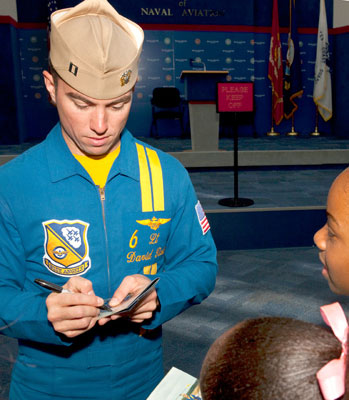
A Blue Angel pilot signing autographs
Located at the Pensacola Naval Air Station, a
training ground for the US Navy and Marine Corps, this museum traces
the history of aviation with thrilling displays. Its amazing
exhibits include over 150 restored aircraft and spacecraft, dating
from the era of the earliest biplanes to the Space Age, and the
Mercury and Apollo space capsules. Hands-on elements include the
chance to sit at the controls of a jet trainer, while practice
sessions by the Blue Angel stunt pilots add to the excitement.
Key
Features
1. MaxFlight Simulator High-tech video
and real motion simulate the feeling of being on a mission in a
high-speed fighter plane.
2. Sunken Treasures The two aircraft
displayed here were used for training during World War II before
they sank in Lake Michigan. They were recovered from the lake,
remarkably well preserved by the cold water.
3. Cockpit Trainers Kids can climb
into cockpits, including those of the A-4 Skyhawk and Corsair
II, in this simulated flying experience.
4. The IMAX® Theater Four different
features are shown daily on one of the largest IMAX® screens in
the world. The Magic of Flight is a regular on the
schedule.
5. Blue Angels Check out the display
of four A-4 Skyhawks, used by the daredevil Blue Angels,
suspended from the ceiling of a seven-story glass atrium.
6. USS Cabot Flight Deck See the replica of a
flight deck, and the superstructure of a World War II aircraft
carrier, complete with fighter planes.
7. Space Capsule Display Here, space
exploration exhibits include a Skylab Command Module, a Mercury
capsule, and a Moon Rover vehicle. Astronaut suits and
memorabilia are also on display.
8. Biplane With one wing fixed above
the other, biplanes were important early aircraft used in World
War I. They are favorites in barnstorming air shows today.
9. Hangar Bay One On display are
aircraft of the post-World War II era, including a Marine One
presidential helicopter and a replica of the Apollo 17 lunar
module. There is also a section on Coast Guard aircraft and
prisoners of war.

Left Biplane Middle
Four A-4 Skyhawks Right IMAX Theater screen
Kids’ Corner
How many can you find?
The museum has hundreds of aircraft on
display. See how many of these you can find during your
visit:
A6 Intruder
C117 Skytrain
J2F Duck
K47 Airship Control Car
OS2U Kingfisher
PBY Catalina Cutaway
RF-4B Phantom II
RR-5 Trimotor
The first naval air station
Pensacola was the site of the nation’s
first naval air station, founded in 1914. It was here that
pilots learned the special skills required to take off and
fly from ships at sea.
The Blue Angels
Sixteen Navy and Marine officers are
chosen to fly in the Blue Angels. The selection process
requires them to apply formally, and they usually serve for
two years. Pilots chosen must have at least 1,250 tactical
jet flight-hours and the commanding officer, known as “The
Boss,” must have 3,000 hours. The group has been flying
since 1946 and they put on more than 70 shows each year.
Pilots to guide
The guides at the museum are volunteers –
retired veterans who have first-hand flying experiences to
share.
< The
Panhandle
7. Tallahassee
Tons of Southern charm
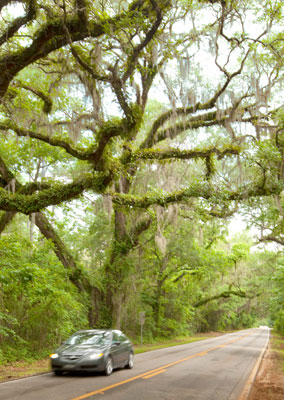
The canopied Meridian Road, Tallahassee
Encircled by rolling hills and dotted with pine
forests, this state capital has a rich Southern flavor. This former
site of an Apalachee Indian settlement is now home to several
historical museums. Located in the heart of the city, and spreading
over several landscaped blocks, the Capitol Complex offers much to
see and do for all ages. Pretty gardens, the nearby beaches,
beautiful canopied roads, and a wide choice of dining venues are
further lures to this city.
Key Sights
1. Florida State University This
university is noted for its highly regarded music and theater
departments, which stage concerts and plays during the school
year.
2. Museum of Florida History
Prehistoric mastodons, Native American exhibits, and a replica
riverboat brings the state’s past to life in this excellent
museum.
3. Florida State Capitol Built in
1977, the tower behind the Historic Capitol houses art exhibits
on the main floor. The 22nd floor observation deck offers views
for miles around.
4. Florida Historic Capitol Museum See
the house and senate chambers, the governor’s suite, and the
supreme court, all restored just as they were in the state’s
original columned capitol.
5. Park Avenue Historic District This
central chain of green parks is lined with 27 homes that predate
the Civil War. Built around 1830, the oldest one, The Columns,
houses the James Madison Institute.
6. Lake Ella One of Tallahassee’s many
lakes, Lake Ella is centered by a spraying fountain and circled
by a paved walking trail. The surrounding park has picnic tables
and some quaint shops.
7. Goodwood Museum and Gardens
Discover what life was like for kids in the South long ago in
this 1834 plantation house, where much of the original art and
furnishings have been restored.

Left Museum of Florida History
Middle Florida State University
Right Florida State Capitol
Kids’ Corner
Capitol Museum quiz
What year did Tallahassee
become the state capital?
The city’s first mayor,
Francis W. Eppes, had a famous grandfather. Who
was he?
Florida State University is
the oldest state school. What was the school
called before it became a co-ed in 1947?
Canopied roads
Tallahassee is known for its canopied
roads, where moss-draped live oaks and other trees have
grown so tall that their limbs meet to shade the roads
beneath them.
Capital Fighters
Tallahassee was the only Southern capital
east of the Mississippi River not captured by the Union
during the Civil War. Most men were off serving in the
Southern army, but when warned of a pending attack, local
volunteers – old men and young boys – met the Union forces
at Union Bridge and fought off three major attacks.
Where the four shall meet
In Colonial times, the only part of
Florida that was settled was the north and there were just
two major towns, St. Augustine and Pensacola. According to
legend, a rider set out on horseback from each town and at
the spot where they met, the capital city of Tallahassee
grew up.
< The
Panhandle
8. Mission San Luis
Time travel back to the 1600s
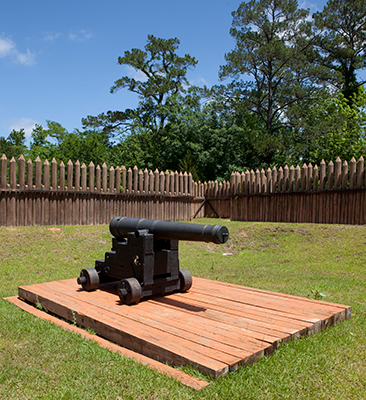
A cannon on display in the gardens at Mission San
Luis
Costumed interpreters bring to life a reconstruction
of one of Florida’s rarest sites: a 1600s mission that was shared by
Spanish settlers and the native Apalachee Indians. This unusual
cooperation worked because the Spanish needed labor and provisions while
the Apalachee Indians wanted peace and prestige. The arrangement lasted
until 1704, when both groups fled from British invaders. See the
enormous, five-story Indian Council House with its palm-thatched roof.
It stands next to a Franciscan church that was constructed by the
Apalachee Indians under Spanish supervision. The defensive fort, El
Castillo de San Luis, has been re-created, and a Spanish home and
working gardens portray everyday life in a community of 1,600 people.
The excellent on-site museum traces the archaeological excavations of
the area and displays artifacts found during the digs, such as tools and
pottery.
Kids’ Corner
A really big house
The council house at Mission San Luis is
one of the largest Apalachee Indian structures ever. It is
wider than the length of a football field, and 100,000 palm
fronds were used to cover the roof.
Play ball
Drawings at Mission San Luis show a ball
game that was played here by the Apalachee Indians hundreds
of years ago. The game involved 50 or more players using a
ball about the size of a golf ball, made of hardened clay
and covered with buckskin. The triangular goal post was
crowned by the target: an eagle’s nest. The game was
dedicated to the gods of rain and playing it was supposed to
ensure water for crops.
< The
Panhandle
9. Tallahassee Museum
A farm, a plantation, and a zoo – in a
museum
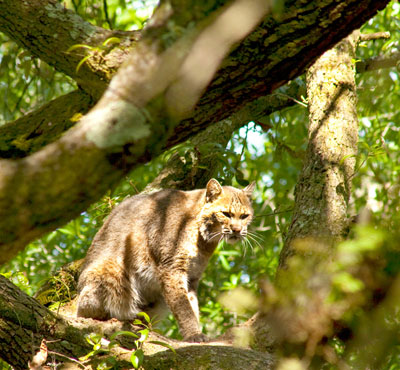
A bobcat in the zoo within the Tallahassee Museum
grounds
Popular with children, this sprawling, multifaceted
museum can entertain for hours. Visit farm animals such as cows, sheep,
goats, and pigs in the Big Bend Farm, an 1880s farm complete with
reconstructed and restored buildings. The garden grows crops such as
corn, cotton, and sugarcane. The museum also has a zoo that features
Florida wildlife in natural habitats – there are black bears, a red
wolf, a black panther, bobcats, playful river otters, and a Florida
alligator. Other attractions include a restored plantation that has an
original home, a kitchen, and a slave cabin – a dwelling that tells of a
time when slaves were brought from Africa against their will to work the
fields on Southern plantations. Families can take a walk on the nature
trail, head indoors to experience the hands-on exhibits in the Discovery
Center, or discover underwater life in the Fleischmann Natural Science
building. The latter has two small freshwater aquariums and an
observation window to watch birds feeding outside.
Kids’ Corner
Official questions…
You can see Florida’s official
state animal and state reptile at the zoo at
Tallahassee Museum. What are they?
If you are lucky, you might
spot the official Florida state bird around the
museum’s grounds. What is it?
< The
Panhandle
10. Alfred B. Maclay Gardens State Park
A floral wonderland
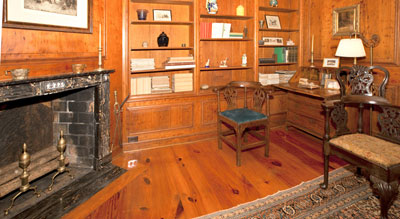
An elegantly furnished room in Maclay House, Alfred
B. Maclay Gardens State Park
Alfred B. Maclay, a New York financier, and his wife
Louise planned the gardens in the grounds of their winter home in 1923.
This blooming oasis, with over 200 varieties of plants, is a vision in
late winter and early spring, when camellias, dogwoods, and azaleas are
in flower. The season lasts from January to April, with the beauty at
its peak in March. Brick walkways and pine needle paths make for a
serene stroll through landscapes that include a walled garden, ponds,
fountains, and a lovely lake. Look for the narrow path leading to a
secret garden. This secluded spot shelters small plants and has pretty
wrought-iron benches that are perfect for a break. Lake Hall provides
opportunities for swimming, fishing, canoeing, and kayaking, and two
nature trails through the woods overlook the lake. Still furnished as it
was when the owners were in residence, the Maclay House is open for
visits from January through April.
Kids’ Corner
Official question…
The Alfred B. Maclay Gardens
have hundreds of blooms, but you probably won’t see the
official state flower unless you visit an orange grove.
What is it?
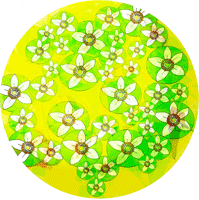
< The
Panhandle
11. Wakulla Springs State Park
Gator-gazing, swims, and walks
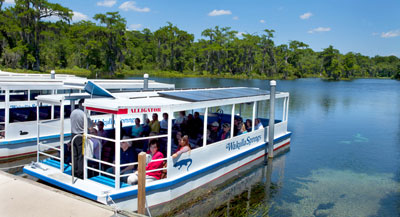
Tour boats at the jetty in Wakulla Springs State
Park
A popular location for Tarzan movies in the
past, Wakulla is home to one of the world’s deepest natural springs.
Spot alligators, turtles, and birds of all shapes and sizes on one of
the park’s daily ranger-led riverboat tours. An observation platform
offers superb views of the springs, and a safe area has been set aside
for swimming; the crystal-clear waters are also great for snorkeling. A
6-mile (10-km) hiking trail weaves through a hardwood forest of magnolia
oak, beech, and hickory, as well as a longleaf pine forest. Be sure to
decide in advance how far to walk, as this is not a loop trail. Built in
Mediterranean style in the 1930s, the park’s handsome Wakulla Springs
Lodge is on the National Register of Historic Places.
Kids’ Corner
Do you know…

A famous movie series was filmed at
Wakulla Springs. Who was the main character?
< The
Panhandle
12. San Marcos de Apalache Historic State Park
Biking, hiking, birds, and a historic fort
This state park is situated in the tiny historic
fishing town of St. Marks on Apalachee Bay. The flags waving over the
entrance mark a site fought over by Spanish, English, American, and
Confederate forces. Though the first Spanish settlement here was built
in 1528, the original fort, now a National Historic Landmark, was built
in 1679. The fort was later replaced by a stone fortress. A museum in
the park exhibits pottery and tools unearthed near the original fort;
and displays and a video reveal the site’s colorful history.
Although a small town today, St. Marks was once a major
port. Built in 1830 to bring cotton from Tallahassee plantations, the
railroad is known today as the Tallahassee-St.
Marks Historic Railroad Trail State Park, a paved 16-mile
(26-km) trail for hikers and bikers ending at the St. Marks waterfront.
Kids’ Corner
Do you know…
1. How many flags have flown over Fort
San Marcos de Apalache?
2. Can you guess how many varieties of
birds can be spotted in St. Marks National Wildlife
Refuge?
Rails to trails
Modern highways and airplane services have
meant that many older railroad tracks are no longer needed.
Formed in 1986, the Rails to Trails Conservancy works to
change the flat beds where rails used to be into paved paths
for bikers and hikers. So far 20,000-plus miles (32,186 km)
of rail-trail have been opened across the US. Visit
www.railstotrails.org
< The
Panhandle
13. Apalachicola
Oyster town
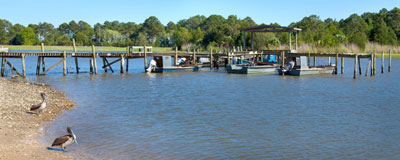
Jetty at Apalachicola Bay, near the town of
Apalachicola
A major seaport when cotton was coming down from
northern Florida’s plantations, this quaint little town waned after the
Civil War (1861–5). But it has a wonderfully walkable Historic District,
with many beautifully restored homes and warehouses. Start with the
walking tour map from the Information Center and take a look at the
town’s 50-plus pre-Civil War buildings, many of which house gift shops
and restaurants. Today, the town relies on the sea for its livelihood,
and is famous for its oysters. A variety of boat trips take visitors out
into Apalachicola Bay.
Kids’ Corner
All about oysters
Apalachicola Bay once produced 90 per cent
of Florida’s oysters. Fluctuations in water salinity reduced
the harvest briefly, but it’s on the rise again. Harvesting
isn’t easy since oysters live in beds at the bottom of the
sea. They are gathered with a scoop-shaped net of metal mesh
attached to the back of a boat.
